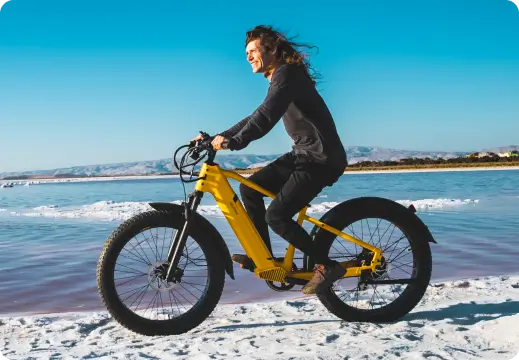Electric bikes continue to grow in popularity across Oregon, from Portland’s urban bike lanes to the paved river trails in Eugene and the scenic routes of Bend. But as ebikes become more common, understanding Oregon’s ebike laws is essential—especially because the state's regulations differ slightly from the standard 3-class system used in most of the U.S.
Whether you're a daily commuter, a recreational rider, or just getting into ebikes, this guide breaks down everything you need to know about Oregon electric bike laws, including age limits, helmet rules, path access, and how Oregon defines an ebike under state law.
How Oregon Defines an Electric Bike
Electric-assisted bicycles are categorized into classes based on factors such as the motor’s maximum power output, the top speeds they can reach, and functionality.
For example, all ebikes have a pedal assist system, which helps propel the bike forward when pedaling. However, not all have throttle assist, which propels the bike forward even when you aren’t pedaling.
There are general industrywide classifications of ebike categories. That said, many states have their own legal classifications of what’s considered an ebike. Oregon is no exception.
Under Oregon Vehicle Code (ORS 801.258), a vehicle qualifies as an electric bicycle if it has no more than three wheels, has a seat or saddle for the rider (unlike a scooter), and has fully operable pedals (unlike a motorcycle or moped, for example).
Additionally, an ebike motor’s power output can’t be more than 1,000 watts. Plus, the motor can’t propel the bike at speeds of more than 20 miles per hour (mph) on level ground. That doesn’t mean you can’t go faster than 20 mph — just that the motor alone (aka throttle assist) can’t be used to power the bike faster than 20 mph.
This means that while many modern ebikes exceed 20 mph with pedal assist, Oregon’s laws were written before higher-assisted speeds became common.
Most enforcement in Oregon focuses on safe speed, proper path use, and age restrictions rather than strict motor-power interpretation.
Oregon and the 3-Class ebike system
Oregon does NOT officially adopt the Class 1, Class 2, Class 3 system used in California, Washington, Idaho, Colorado, and many other states.
However, because manufacturers label bikes using the 3-class framework, Oregon generally aligns with these practical distinctions:
✔ Class 1 (Pedal Assist, 20 mph)
Functionally allowed anywhere traditional bicycles are allowed.
✔ Class 2 (Throttle, 20 mph)
Throttle is permitted as long as the bike does not exceed 20 mph under motor power alone.
✔ Class 3 (Pedal Assist, 28 mph)
Higher-speed pedal assist is allowed, but:
- Riders must still follow posted speed limits,
- Some shared-use paths and off-street trails restrict higher-speed travel.
So even though Oregon law hasn’t formally adopted the 3-class system, most riders and local jurisdictions use it as a reference for determining where a bike can operate.

Ebike Laws in Oregon
Now that we’ve established what’s considered an ebike in Oregon, let’s talk about e-bike laws. Below, we outline some key legislation electric bicyclists should know in Oregon.
Where you can ride an ebike in Oregon
Oregon has one of the most extensive bike networks in the country, and ebikes are broadly allowed anywhere traditional bicycles can go—unless signage states otherwise.
✔ Bike Lanes (On Streets)
All ebike types are allowed.
✔ Shared-Use Paths (Paved Trails)
Ebikes are generally allowed, but local jurisdictions may enforce speed limits or restrict high-speed Class 3 operation.
✔ State Parks & Natural Surface Trails
This is where rules vary the most.
- Oregon State Parks often restrict ebikes on non-motorized natural trails,
- Many jurisdictions only allow Class 1-style pedal assist on soft-surface MTB trails,
- Class 2 throttle use may be restricted in natural areas.
Always check the rules for Bend, Eugene parks, Metro parks, Forest Park (Portland), and regional MTB trail systems.
✔ Roadways
All ebikes that meet Oregon’s definition may be ridden on public roads and must follow standard traffic laws.
What class of ebikes are legal in Oregon?
Why do ebike classes matter? Depending on the class, the laws surrounding e-bike use can vary — like where you ride the ebike and whether you have to wear a helmet.
In Oregon, three classes of ebikes are allowed: Class 1, Class 2, and Class 3, as described above. Note that these classifications are unique to Oregon. Other states may have their own definitions for each ebike class.
For example, in New York, a Class 3 ebike can’t go faster than 25 mph, which is different from the 28-mph industry standard.
Do you need a helmet when riding an ebike in Oregon?
Oregon’s helmet law (ORS 814.485) applies to:
- All riders under age 16, regardless of class or power
- Adults are not required to wear helmets by state law, though it is strongly recommended
Some cities—such as Portland—have stricter local requirements for minors.
How old do you have to be to ride an ebike in Oregon?
Oregon law requires you to be at least 16 years of age to ride an ebike. The state is looking to take a tougher stance on underage e-bike cycling and even fine people who cycle without meeting the age minimum.
Children may ride as passengers (such as on a cargo bike), provided they are seated safely, but may not operate the ebike themselves.

Is there a speed limit or restriction on motor power for ebikes in Oregon?
Under Oregon state law, an electric bicycle can’t have a motor with a power output of more than 1,000 watts. An ebike motor also can’t propel the bike independently (without the cyclist pedaling — aka throttle assist) at speeds of more than 20 mph.
Do you need a license, insurance, or registration to ride an ebike in Oregon?
Good news: There’s no need to get a driver’s license for an ebike. Oregon also doesn’t have any registration requirements for electric bicycles.
You also don’t need to get insurance for an ebike. However, ebike insurance can be a smart investment. Depending on the policy and coverage details, insurance can cover everything from ebike repairs to medical expenses following an accident.
Can you ride an ebike on sidewalks in Oregon?
Sidewalk laws are determined locally.
In many Oregon cities—including Portland, Eugene, and Corvallis—bicycles and e-bikes are prohibited from riding on sidewalks in business districts.
In residential and low-density areas, sidewalk riding may be allowed unless posted otherwise.
When sidewalk riding is allowed, cyclists must:
- Yield to pedestrians
- Travel at walking speed
Local ordinances for ebikes in Oregon
The above content covers basic ebike laws that apply across the state of Oregon. However, be aware that local ordinances may differ from general regulations. It’s always worth checking your area’s laws before you ride.
If you’re in an urban space, consult your local police department or DMV. Some cities or counties also have publicly available ordinances.
For example, the city of Eugene, Oregon, has its own guidelines. Class 1 and Class 2 ebikes aren’t allowed on side paths in the Whilamut Natural Area or East Alton Baker Park if the electric motor is on. Also, you can’t use Class 3 ebikes on any shared-use paths.
How Oregon enforces ebike laws
Enforcement focuses on:
- Speeding on multi-use paths
- Riding on prohibited natural-surface trails
- Helmet compliance for minors
- Unsafe operation in high-traffic areas
- Sidewalk restrictions in business districts
While citations are possible, most enforcement occurs through posted signage, education, or verbal warnings.
Oregon is best explored with a Velotric ebike
Familiarizing yourself with Oregon ebike laws can keep you safe when cycling in the state and help you avoid pesky tickets and fines. Besides knowing Oregon ebike laws, you need one other thing: an ebike!
Velotric’s ebikes offer a model for every kind of cyclist. If you’re looking for an urban bike for commuting to work, try the Discover 2. If you want to go off-road and explore the great outdoors, opt for the fat tire Nomad 2X.
Velotric’s bike frames have been rigorously tested and come with a quality lithium-ion battery certified by the global safety standards organization Underwriters Laboratories (UL 2271).
Final Thoughts
Oregon’s ebike laws are more flexible than many states, largely because Oregon has not formally adopted the nationwide 3-class system. Instead, the focus is on safe speeds, appropriate use of shared paths, and ensuring that riders—especially minors—follow basic safety rules.
Regardless of whether you ride a commuter ebike, a fat tire adventure model, or a cargo-focused design, understanding the state’s rules can help you ride confidently across Oregon’s trails, urban bike networks, and scenic routes.
As legislation continues to evolve, especially around higher-speed pedal-assist e-bikes, checking local regulations before exploring new areas will ensure every ride is smooth, safe, and compliant.
Data Sources
The above information is sourced from these websites and was last updated in November 2025. If you have any questions, you can visit the following sites directly for confirmation.
































